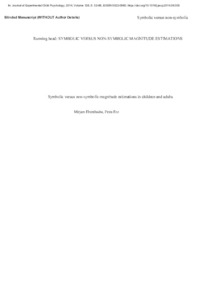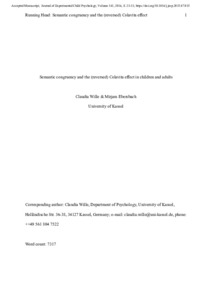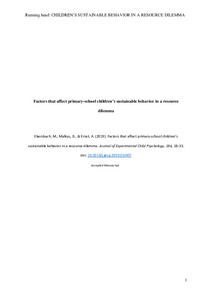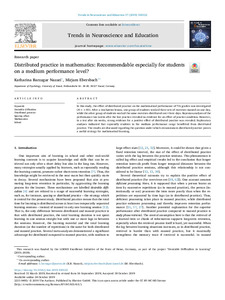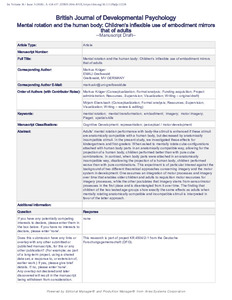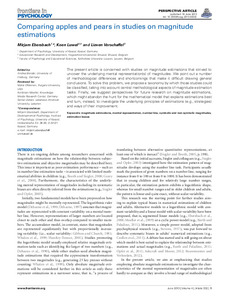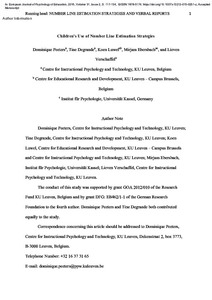Suche
Anzeige der Dokumente 1-10 von 22
Aufsatz

 Symbolic versus non-symbolic magnitude estimations among children and adults
Symbolic versus non-symbolic magnitude estimations among children and adults
(2014-07-30)
The ability of children and adults to generate symbolic and non-symbolic magnitude estimations was examined in the light of their familiarity with numbers. Children (6-year-old kindergartners, 7-year-old first graders, and 9-year-old third graders) and adults made symbolic estimations either by saying number words that matched numbers of dots (i.e., perception task) or by generating numbers of dots that matched given number words (i.e., production task). In the non-symbolic estimation task, participants generated the ...
Aufsatz

 Semantic congruency and the (reversed) Colavita effect in children and adults
Semantic congruency and the (reversed) Colavita effect in children and adults
(2016)
When presented with auditory, visual, or bimodal audiovisual stimuli in a discrimination task, adults tend to ignore the auditory component in bimodal stimuli and respond to the visual component only (i.e., Colavita visual dominance effect). The same is true for older children, whereas young children are dominated by the auditory component of bimodal audiovisual stimuli. This suggests a change of sensory dominance during childhood. The aim of the current study was to investigate, in three experimental conditions, ...
Aufsatz

 Factors that affect primary school children’s sustainable behavior in a resource dilemma
Factors that affect primary school children’s sustainable behavior in a resource dilemma
(2019)
Acting ecologically sustainably and not exhausting natural resources is becoming more and more important. Sustainable behavior can be investigated within the conceptual frame of resource dilemmas, in which users share a common, slowly regenerating resource. A conflict emerges between maximizing one’s own profit and maintaining the resource for all users. Although many studies have investigated adults’ behavior in resource dilemmas, barely anything is known about how children deal with such situations and which factors ...
Aufsatz

 Reading a short story changes children’s sustainable behavior in a resource dilemma
Reading a short story changes children’s sustainable behavior in a resource dilemma
(2019-12-02)
Fostering sustainable behavior in children and adolescents should be a central aim of today’s education. Even though the interplay of factors affecting sustainable behavior is complex, simple interventions can be effective too. In the current study, 10-year-olds (N = 132) were read a short story about two foresters who collectively used a forest to gain timber, facing a resource dilemma that involved striving for maximizing their individual profit while sustaining the forest. In the story, the foresters solved the ...
Buch
 Warum Mädchen und Frauen reiten
Warum Mädchen und Frauen reiten
(Gesamthochschul-Bibliothek, Kassel, 1994)
Aufsatz

 Distributed practice in mathematics: Recommendable especially for students on a medium performance level?
Distributed practice in mathematics: Recommendable especially for students on a medium performance level?
(2019-10-24)
In this study, the effect of distributed practice on the mathematical performance of 7th graders was investigated (N == 81). After a stochastics lesson, one group of students worked three sets of exercises massed on one day, while the other group of students worked the same exercises distributed over three days. Bayesian analyses of the performance two weeks after the last practice revealed no evidence for an effect of practice condition. However, in a test after six weeks, strong evidence for a positive effect of ...
Aufsatz
 Mental rotation and the human body: Children's inflexible use of embodiment mirrors that of adults
Mental rotation and the human body: Children's inflexible use of embodiment mirrors that of adults
(2018)
Adults’ mental rotation performance with body‐like stimuli is enhanced if these stimuli are anatomically compatible with a human body, but decreased by anatomically incompatible stimuli. In this study, we investigated these effects for kindergartners and first‐graders: When asked to mentally rotate cube configurations attached with human body parts in an anatomically compatible way, allowing for the projection of a human body, children performed better than with pure cube combinations. By contrast, when body parts ...
Aufsatz

 Comparing apples and pears in studies on magnitude estimations
Comparing apples and pears in studies on magnitude estimations
(2013-06-18)
The present article is concerned with studies on magnitude estimations that strived to uncover the underlying mental representation(s) of magnitudes. We point out a number of methodological differences and shortcomings that make it difficult drawing general conclusions. To solve this problem, we propose a taxonomy by which those studies could be classified, taking into account central methodological aspects of magnitude estimation tasks. Finally, we suggest perspectives for future research on magnitude estimations, ...
Aufsatz

 Implementing Distributed Practice in Statistics Courses: Benefits for Retention and Transfer
Implementing Distributed Practice in Statistics Courses: Benefits for Retention and Transfer
(2020-11-18)
The present study investigated the effect of distributed versus crammed practice before a course deadline on the retention and transfer of knowledge, and whether learner characteristics moderate the effect. In Experiment 1, only 41% (N = 38) of the initially enrolled students worked the voluntary but recommended practice tasks. Moreover, markedly fewer students did so in the distributed condition (12%) than the crammed practice condition (29%). In Experiment 2, working the practice tasks was mandatory and more students ...
Aufsatz
 Children’s use of number line estimation strategies
Children’s use of number line estimation strategies
(2015-03-22)
This study tested whether second graders use benchmark-based strategies when solving a number line estimation (NLE) task. Participants were assigned to one of three conditions based on the availability of benchmarks provided on the number line. In the bounded condition, number lines were only bounded at both sides by 0 and 200, while the midpoint condition included an additional benchmark at the midpoint and children in the quartile condition were provided with a benchmark at every quartile. First, the inclusion of ...

